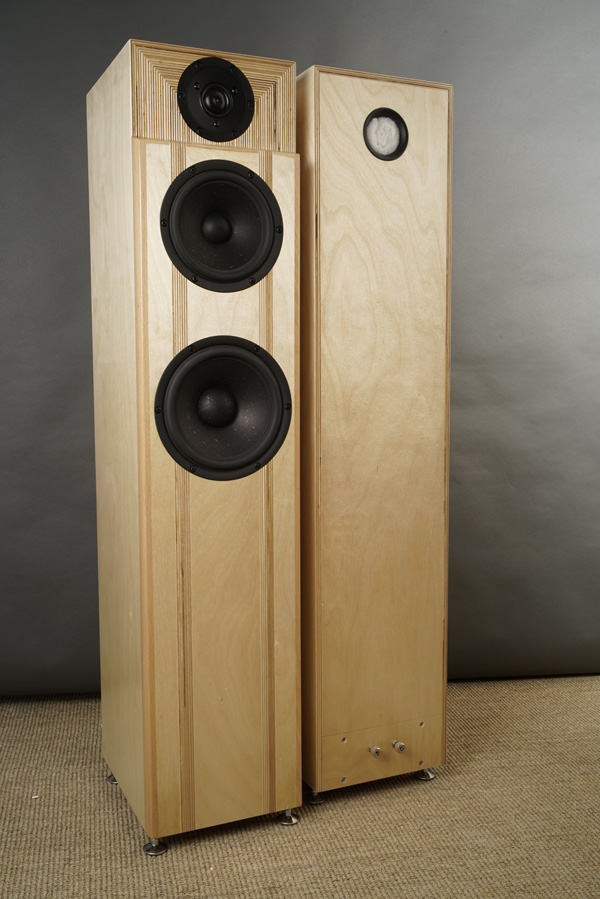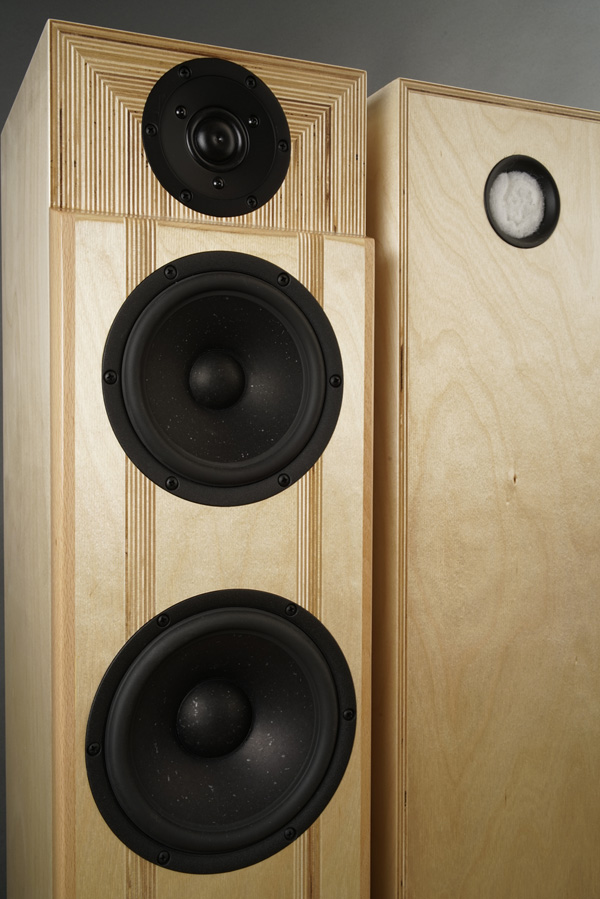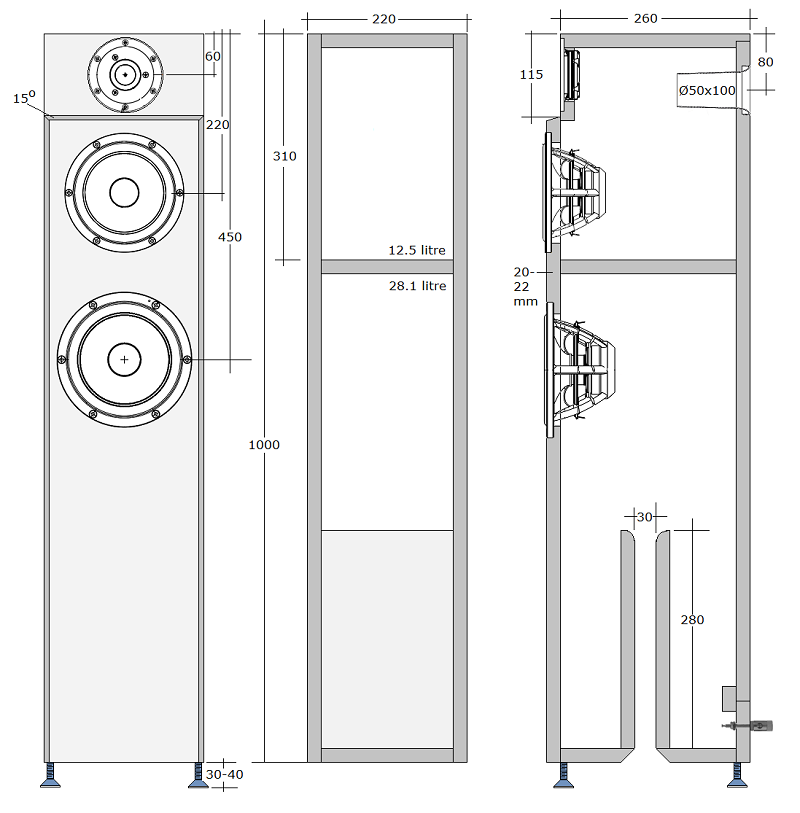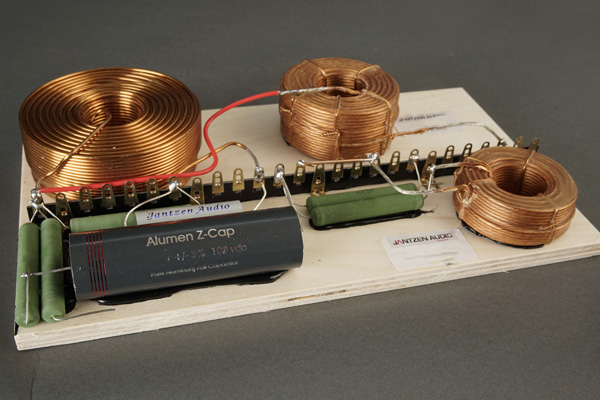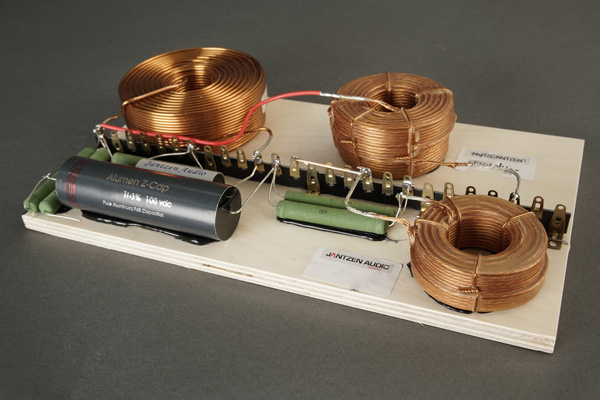DIY Loudspeakers: HOME INDEX UPDATES RESPONSE WHAT'S NEW
SBA-761
Copyright 2021 © Troels Gravesen
Go to on this page:
DRIVERS
CROSSOVER
CABINET
MEASUREMENTS
SPEAKER-KIT
CROSSOVER LAYOUT
A 2½-way with Satori drivers has long been on my to-do list and in
particular mating the MW16 and MW19, the latter giving quite a lot extra
power in the lower registers. The two drivers are very much alike except
for size, thus has the same sonic signature and well suited for a 2½-way
despite being slightly different in size.
The MW16+19 combined make some 277 cm^2 membrane area, close to a 10"
bass driver and it pays of in bass and not least upper-bass and
lower midrange. This is a very important frequency range giving
volume to grand piano and the cello and if good, makes us - at least for
some time - forget about the missing 15" bass driver. We can't have it
all from a skinny floor-stander, but getting this frequency range right
we've come a long way.
The MW16 is one of the few drivers allowing a 1st order crossover, thus
just a single coil to this driver. Overall the crossover topology is
much inspired by my two most recent constructions, thus no
high-pass filter for the MW16 and having this in an smaller aperiodic
cabinet allows quite some power handling.
The tweeter works 1st order down to around 2 kHz from where it gradually
declines 2nd to 4th order.
The sound of speakers featuring 1st order crossovers may sound quite
different from what we're used to. The naturalness of treble and
midrange is unusual, and so is the dynamics. I find the SBA-761
extremely dynamic with a strong midrange presence that never gets
aggressive - given you have good amplifications and source material.
Having the 7½" MW19 helping at the bottom really helps throwing a decent
punch and bottom weight given the overall modest size of the speaker.
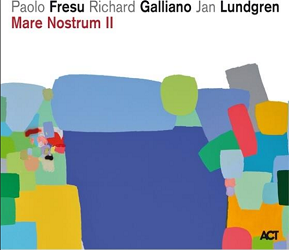
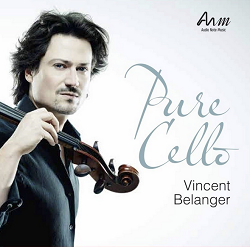
My EAR-861, 32 wpc tube amp, just loves these 90 dB speakers and playing
the 45 rpm Mare Nostrum LP just sounds marvelous. Unfortunately I don't
have my NOMEX-164-mkII any more, which would be a reasonable comparison,
but I'm sure this SBA-761 betters the NOMEX, albeit at a higher price.
Very few drivers can be run 1st order - but the MW16 can.
Equally well does the phenomenal 45 rpm LP from Vincent Belanger. The
cello here comes with a credible low-end weight this recording demands.
Fine-tuning the SBA-761 made me go through a wider range of my
recordings than usual. Again 1st order filters throw a more truthful
presentation and clearly demonstrates that phase shifts are one of the
enemies of hi fidelity. The flute, the obo, the violin, etc., came with
a vivid, yet smooth presentation without any harshness to the ear,
something we've gotten so used to that we think this is the way things
must sound. I'm not pointing fingers because there are a lot of
good speakers out there that doesn't use 1st order filters - in fact
most of them - and some of them sounds darn good. Every speaker is a
compromise from design priorities.
Basics:
2½-way,
3-driver floor-stander.
Dimensions: 22 x 28 x 103 cm, WxDxH (incl. feet).
System sensitivity: 90 dB/2.8V/1 meter.
Impedance: 4-8 Ohms.
Point of crossover: 2300 Hz.
Power requirement: 20+ watts/channel.
Power handling: 100 watts. Please
also read:
http://www.troelsgravesen.dk/power-handling.htm,
and remember any burned driver is a misused driver.
Useful links (Please
follow all links before e-mailing!):
http://www.troelsgravesen.dk/tips.htm
http://www.troelsgravesen.dk/tips.htm#CONSTRUCTION_OF_CROSSOVERS
http://www.troelsgravesen.dk/crossovers.htm
http://www.troelsgravesen.dk/LCR-RC.htm
http://www.troelsgravesen.dk/Inverted-Polarity.htm
http://www.troelsgravesen.dk/choices.htm
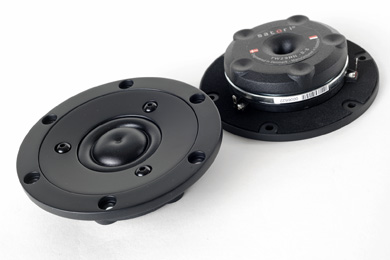
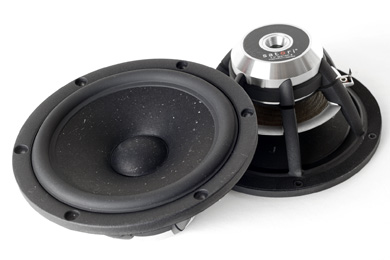
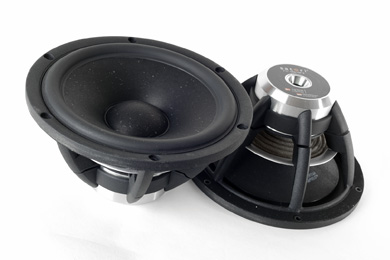
Click images to view large
Download driver specs:
TW29RN-B-8
MW16P-8
MW19P-8
Two Be dome tweeters were tested in this application, the TW29BN-B-8 and SB29BAC-C000-4 and I wasn't completely satisfied with the tonal balance. Due to the first order crossover, we have a little too much energy in the 4-6 kHz range and too little energy above 10 kHz. If you're for a more vivid treble presentation you may try the SB29BN-B-8 without any changes than setting R1 to 6.8 Ohm. I think the TW29RN-B-8 is the best, but the choice is yours. With the 4 Ohm SB29BAC-C000-4, the tweeter section must be re-worked. I haven't done this and shall not, so please don't ask.
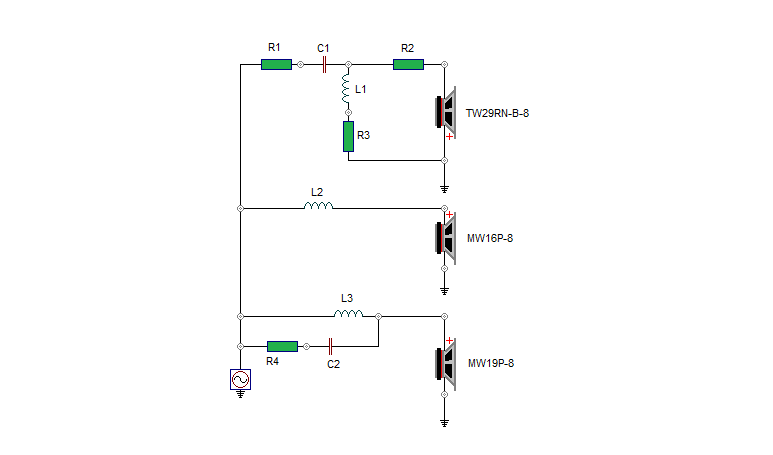
The filter features a 1st order topology and overall simplicity. R4/C2
help suppressing at little too much energy of the MW19 in the 5-10 kHz
range. I've tried it with and without this RC circuit and it's clearly
audible when running the MW19 alone, not so much when all drivers are
connected, yet I find it worth while not having the MW19 mingle with the
treble range, even a little bit.
Should you choose different brand coils L3 can be 0.2-0.5 Ohm, L2
0.1-0.4 Ohm and L1 0.1-0.3 Ohm.
When it comes to crossover layout,
please also read this page:
http://www.troelsgravesen.dk/LCR-RC.htm
Cabinets were made from 20 mm Baltic birch throughout. 19-22 mm MDF can
be used. No further drawings or CAD files available. This is as simple
as it gets. Around 2.5 sqm of 20 mm Baltic birch/MDF should be enough
for two cabinets.
All internal panels except front panels were added 8 mm felt damping.
1.5 sqm in kit.
MW16 cabinet was added 125 grams wool and the Ø50 x 100 mm port stuffed with a roll
of 100 x 150 mm acoustilux.
The MW19 cabinet was added two layers of acoustilux on top and behind
driver, 18 x 50 cm. See photo.
The cavities next to the port at the bottom were each added 2 pieces of folded acoustilux, 18 x 50 cm. In total
12 pcs of 18 x 50 cm = ~1.08 sqm
acoustilux. 1.2 sqm provided in kit.
Height above floor is 30-40 mm. I use 30 mm and the impedance graphs
below is recorded with this height.
The crossover can be placed on the rear panel behind MW19 driver. You
can also place the crossover at bottom to the rear by making a bigger
hatch and even seal off the crossover by placing a top on the cavity
like seen below. Increase cabinet depth to compensate for loss of
volume.
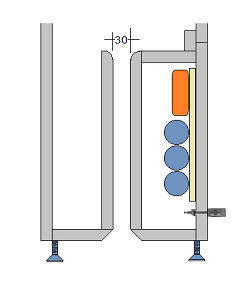
As always: Any change to front panel dimensions, layout or drivers' placement and you need a new crossover - and I can't help.
Workshop pics
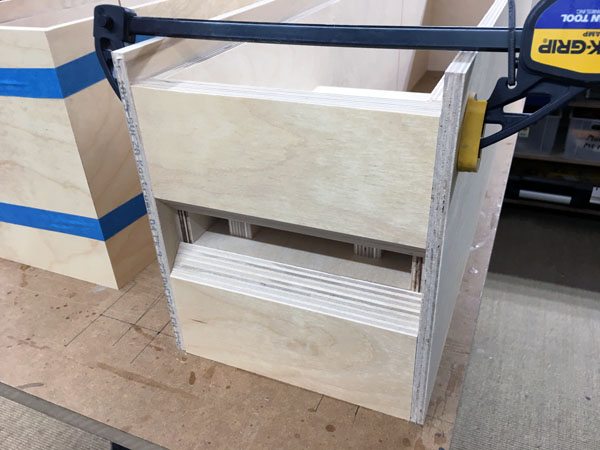
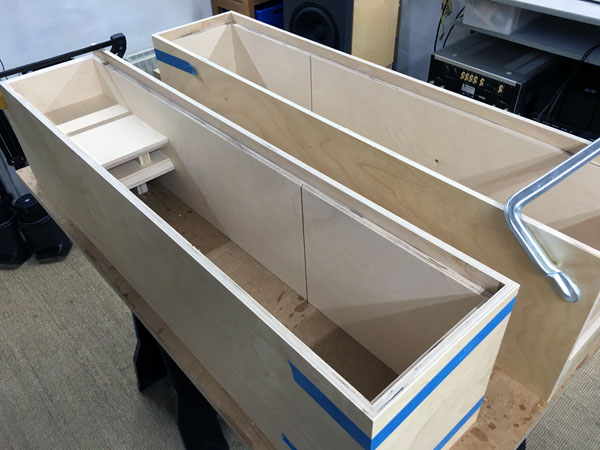
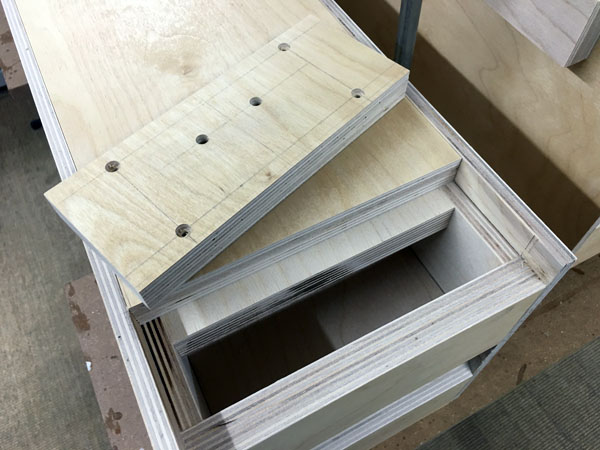
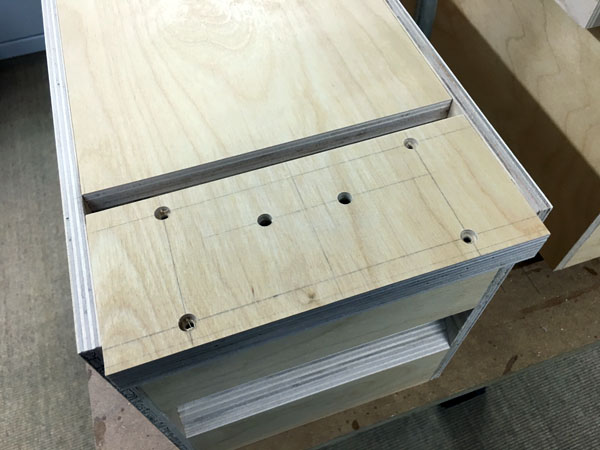
Having the port in the middle at bottom doesn't allow access to the
terminals, thus the above solution.
I used 20 mm panels throughout, not laminated as I often have the
question.
What you see is a rebate for the rear panel, not laminated panels.
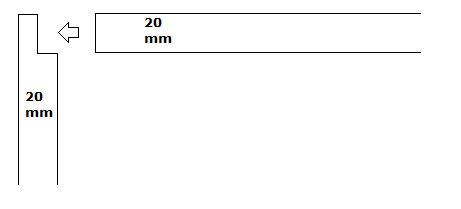
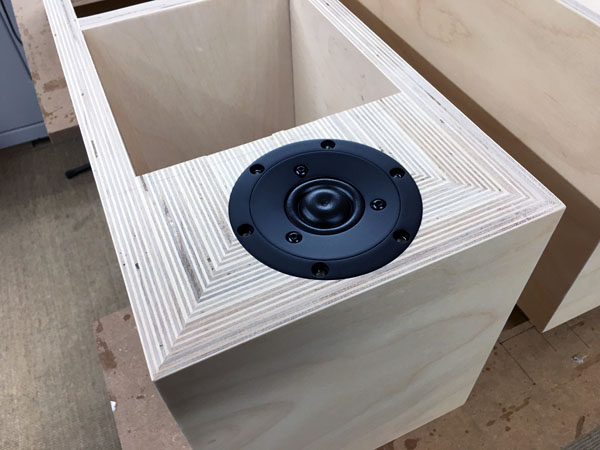
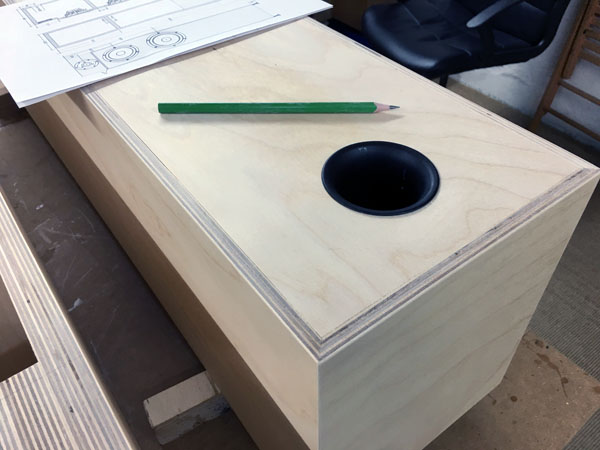
Tweeter panel and upper port in place.
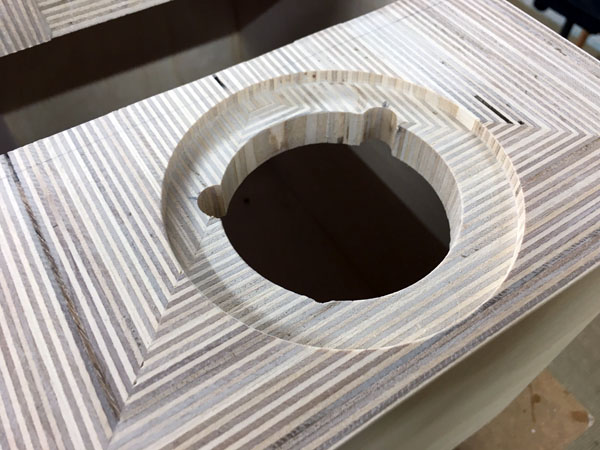
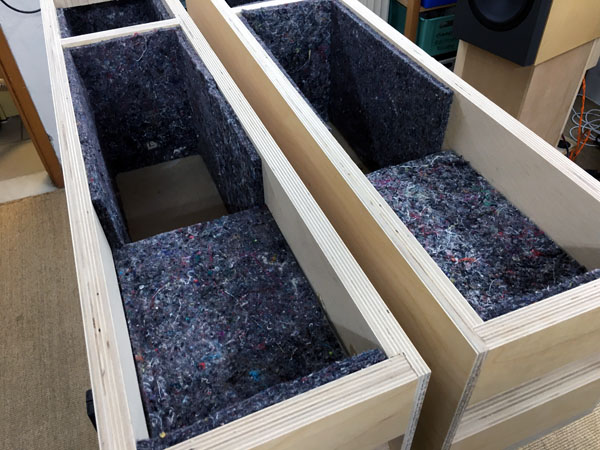
Damping of cabinets.

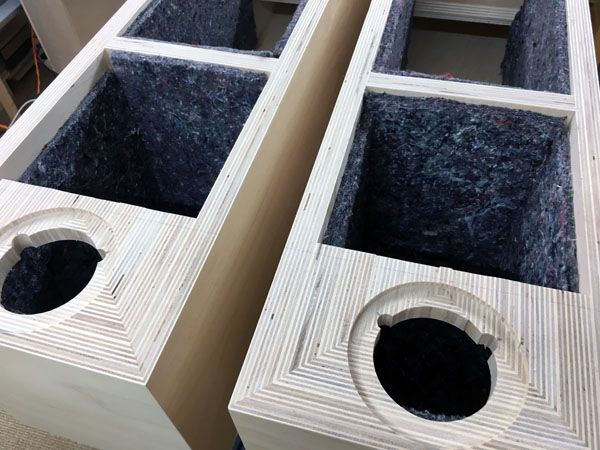
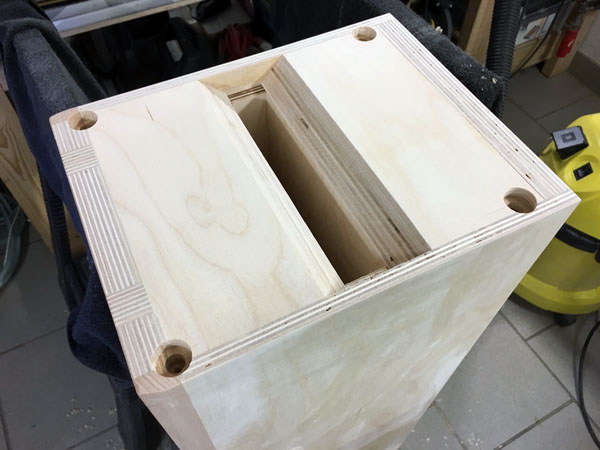
Preparing for the feet. Nuts fastened with epoxy.
The cabinets should have a clearance of min. 30
mm above floor level to allow the port to breathe.
Obviously you can use wooden blocks, spikes or whatever you may fancy.
Check Jantzen catalog here:
http://www.jantzen-audio.com/wp-content/uploads/2019/10/Spikes-Catalogue.pdf
Personally i dislike spikes as I move speakers a lot. Choice is yours
and they are not included in the kit. Order together with kit if you
want to use spikes.
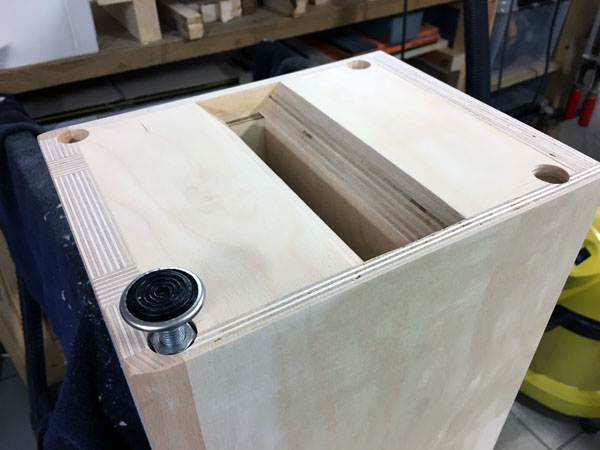
MW16 cabinet filled with 125 grams lambswool.
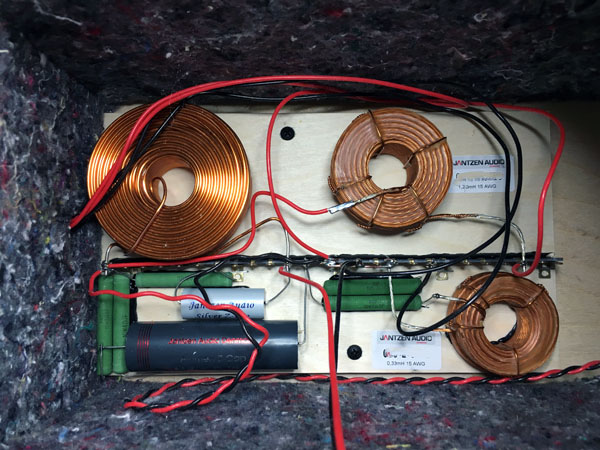
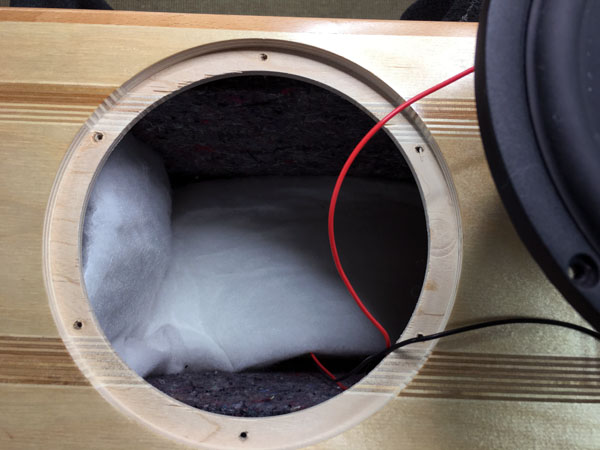
Place crossover on rear panel behind MW19 driver and cover with two
layers of 18 x 500 mm acoustilux also covering the top MW19 panel.
A few comments on
MEASUREMENTS before you start interpreting the readings below.
First of all, if we think measurements will
tell us how a speaker sounds, we're wrong. The perception of sound is
way too subjective to be reflected in any measurements we can perform. A
loudspeaker system is meant to give us a satisfying idea of an acoustic
event and for some people a pair of 5 USD ear-plugs are enough, others
spend 200 kUSD on a truly full-range pair of speakers - and the latter
may not be happier than the former.
Measurements may give us an idea of tonal balance of a system, i.e. too
much or too little energy in certain areas, although dispersion
characteristics play a vital role here. A two-way 7+1 and a three-way
7+4+1 may display similar horizontal dispersion, yet sound very
different. Measurements may tell us about bass extension if far-field
measurements are merged with near-field measurements. In addition to
this, ports may contribute to bass extension. Most of we diy'ers do not
have access to an anechoic room for full-range measurements from
20-20000 Hz.
What cannot be seen is what kind of bass performance we get in a given
room. Bass performance is highly dependent on in-room placement of your
speaker and the same speaker can be boomy in one place and lean in
another. Actual SPL level at 1 meter distance and 2.8V input is useful
for en estimate of system sensitivity and combined with the impedance
profile may give an idea of how powerful an amplifier is needed to drive
the speaker to adequate levels.
What measurements do not tell is the very sound of the speaker unless
displaying serious linear distortion. The level of transparency, the
ability to resolve micro-details, the "speed" of the bass, etc., cannot
be derived from these data. Distortion measurements rarely tell much
unless seriously bad, and most modern drivers display low distortion
within their specified operating range.
Many people put way too much into these graphs and my comments here are
only meant as warning against over-interpretation. There are more to
good sound than what can be extracted from a few graphs. Every graph
needs interpretation in terms of what it means sonically and how it
impacts our choice of mating drivers, cabinet and crossover design.
What measurements certainly do not tell is the sonic signature of the
speaker, because speaker cones made from polypropylene, aluminum,
Kevlar, paper, glass fiber, carbon fiber, magnesium, ceramics or even
diamonds all have their way of adding spices to the stew. Nor do
measurements tell what impact the quality of the crossover components
add to the sound, from state of the art components to the cheapest of
coils and caps, they all measure the same if values are correct, yet
sound very different.
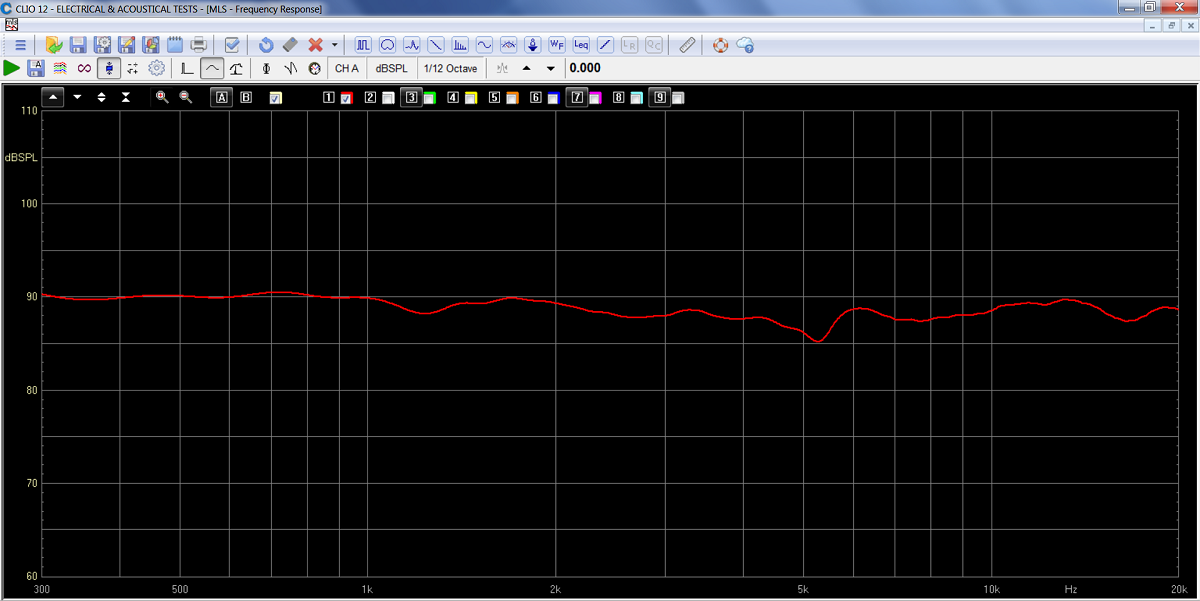
Overall system sensitivity is around 90 dB/2.8V/1meter.
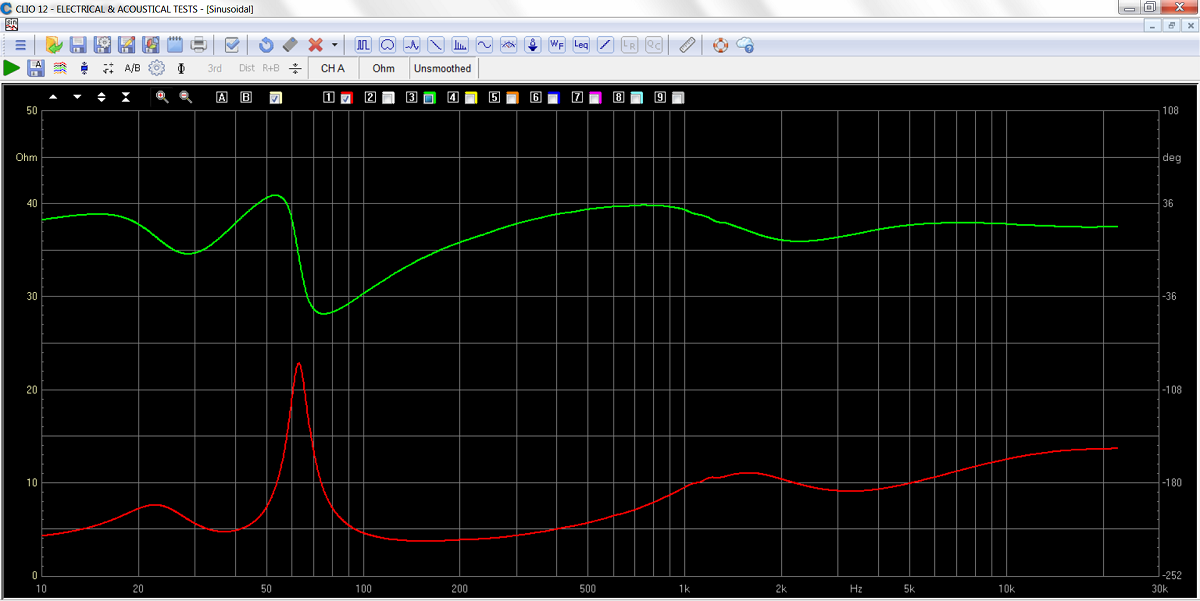
Final system impedance. Minimum 3.7 Ohms. Fairly easy load on the
amplifier. As said, my 32 wpc tube amps runs these speakers with grace
and punch.
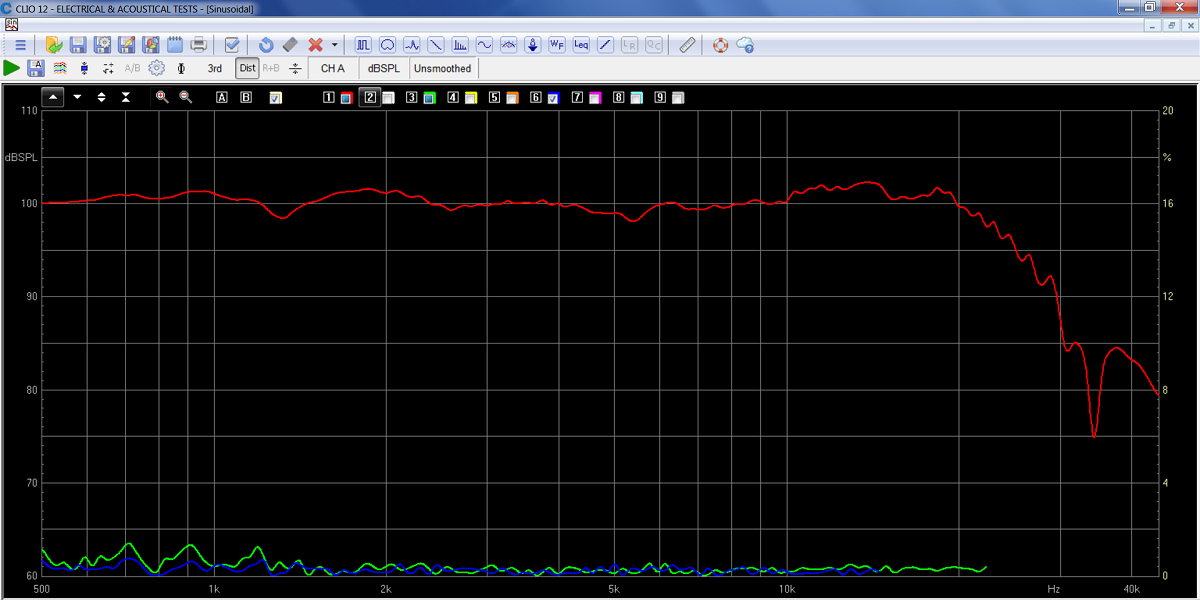
Distortion measured at 0.25 m distance @ 2.8V input. Green = 2nd harm.,
blue = 3rd harm.
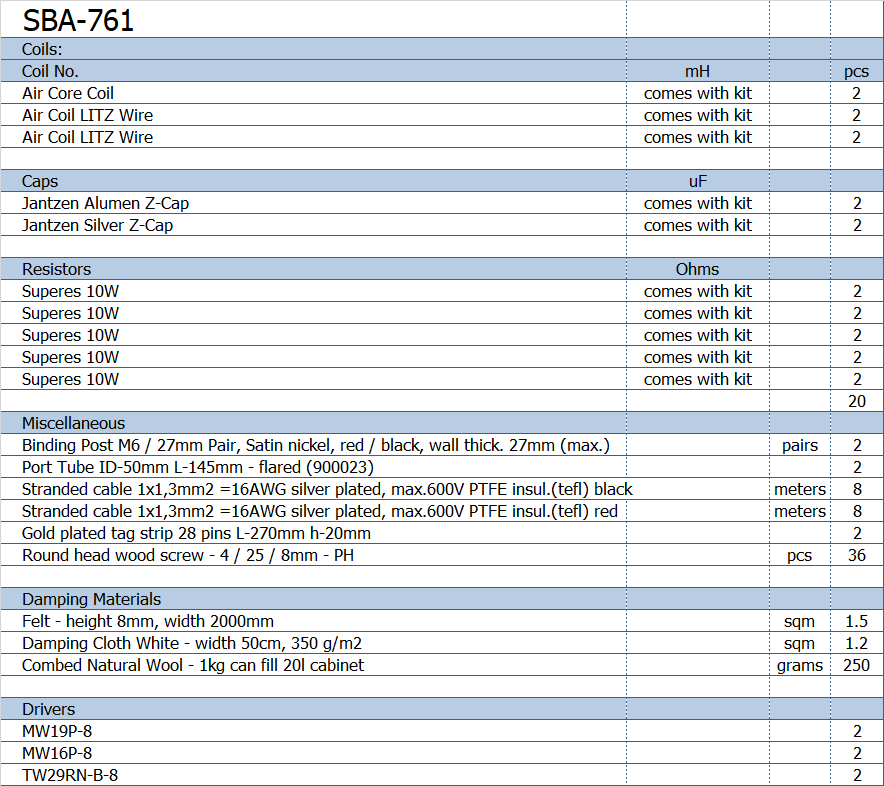
4.7 Ohm Superes is for extra option of
tweeter attenuation.
All kit and component prices may be subject to change and are always to be confirmed by Jantzen Audio Denmark.
Download Kit
Sale Presentations:
All technical questions to troels.gravesen@hotmail.com
All questions regarding purchase of kits, please mail Jantzen Audio at contact@jantzen-audio.com
CROSSOVER-LAYOUT
BACK TO INDEX
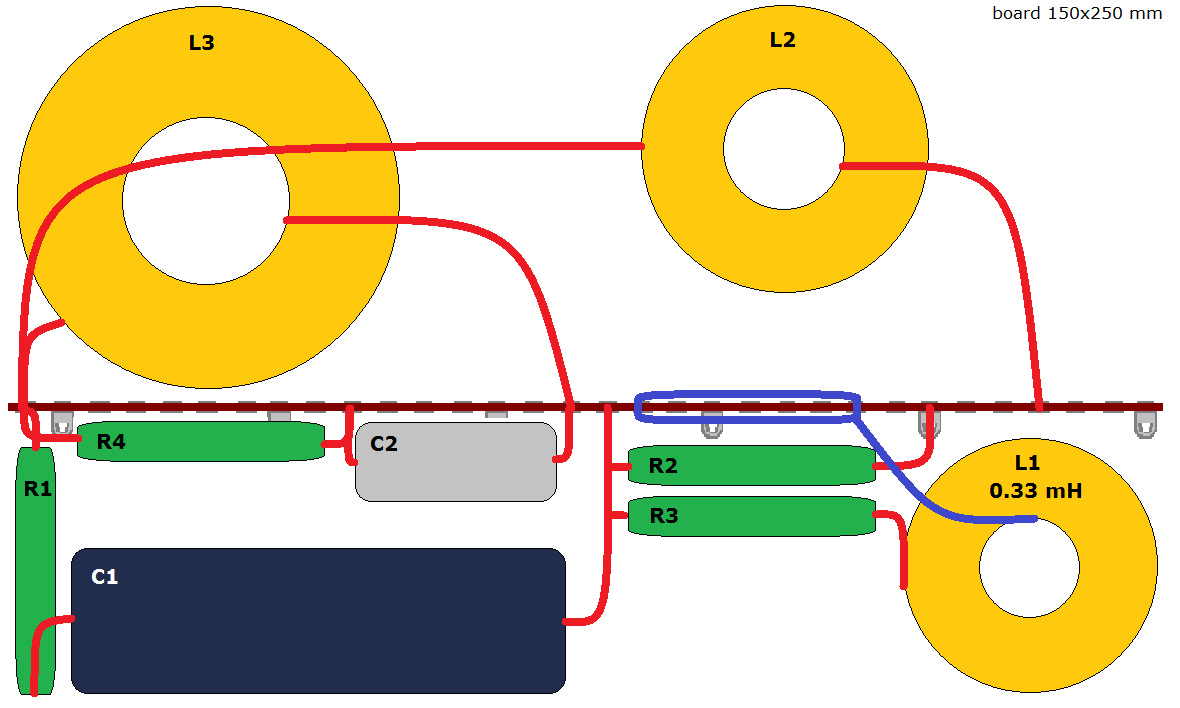
If you want higher treble level, use 4R7 for R1. Place next to 5R6 if wanted.
WIRING OF SPEAKER
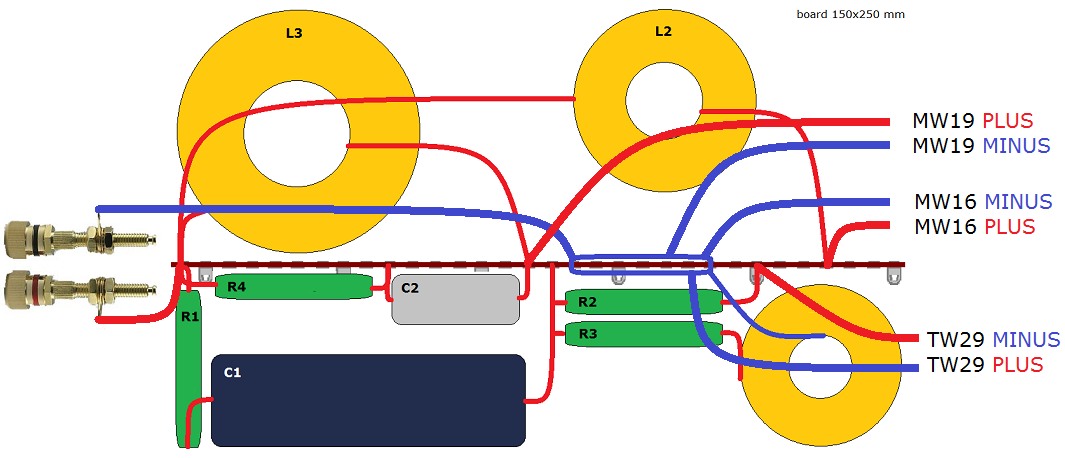
Use wire from input on board to connect to L2.
